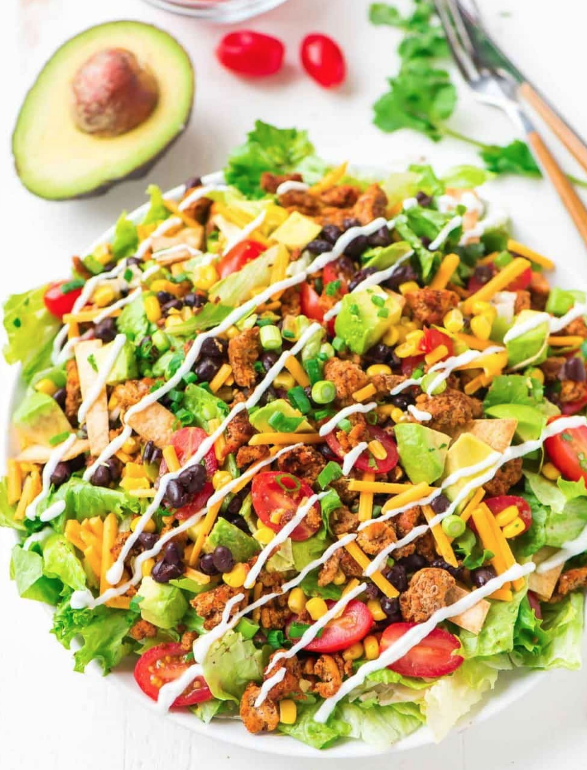by Amy Plano | Oct 1, 2018 | General Nutrition
It’s National Taco Day – Grab Those Partay Pants
First of all — stop the press. Did you know that TODAY, October 2nd is National Taco Day?
I know. First, it was National Peanut Day. Now this. Can you even stand the excitement? Don’t get me wrong. I know that every Tuesday is in fact Taco Tuesday. But most importantly today is THE Taco Tuesday.

I have NEVER met a taco I did not like 🙂
I don’t know about you but I love Mexican food. I can pretty much eat some rendition of Mexican food every day. After all, what is there NOT to like about Mexican food? First there is meat, then cheese, guacamole, jalapenos, tomatoes and might I add … maybe more cheese? So let’s celebrate this glorious day with some healthy Mexican taco recipes. Yes you heard that right. Mexican CAN be healthy. I got you covered, I promise.
Buen provecho! (Enjoy your meal in Spanish).
Taco Bowls
I am a bowl and spoon type of girl. So that is why I lead the list of recipes with 9 Healthy Taco Bowls for When you Want to Ditch the Shell. For me, the actual taco shell just does not do it. Also it’s what inside the shell that really counts and the possibilities are seemingly endless. Most importantly, there is something in this list of recipes for everyone here. Meat eaters and vegans alike can hold hands and dig in knowing their respective bellies will be full.
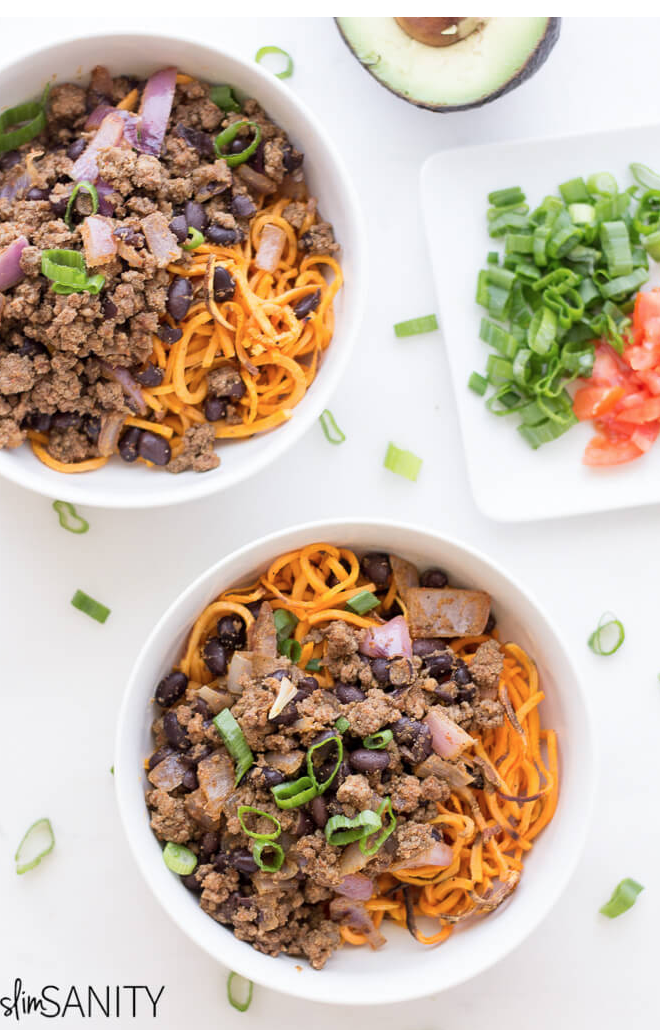
Check out these tasty taco bowls from Slim Sanity! Yum!
Watching your carbs? Then check out this easy recipe for Turkey Taco Spaghetti Squash Boats. Vegetarian? Or ground turkey meat just not your thing? Why not try substituting Boca Crumbles or Beyond Beef Crumbles. You will not even miss the meat 🙂
Taco Stuffed Peppers
From my experience people seem to have a ‘love or hate’ relationship with peppers. So for all the lovers out there I am sharing my favorite recipe for Taco Stuffed Peppers by the Cozy Cook. I am hopeful once you try these this bad boys stuffed with ground beef, cheese, salsa and sour cream – the fact they are even peppers will become a non-issue.
Just a couple of substitutions I would suggest to this recipe. I am assuming the ground beef is referring to an 80/20 blend. I would suggest either ground sirloin which is generally 93/7 or 90/10 depending on the brand. Or you could also substitute ground chicken or ground turkey to lower the saturated fat content of the recipe as well. The Boca Crumbles or Beyond Beef Crumbles would also work lovely here as well.
Taco Seasoning – Avoiding the Ick Factor
As for the Taco Seasoning in this recipe most commercial packets are loaded with sodium and often even MSG. So what I might suggest is you either make your own special blend or choose a low sodium brand with the least number of words you cannot pronounce.
Don’t believe me that there are all sorts of wacky things in your taco seasoning click here to find out what is lurking. Note the second ingredient is salt. Also in case you didn’t know the term “partially hydrogenated soybean oil” is just a fancy name for trans fats. Don’t let the trans fats crash our Taco Tuesday party.
Here is a simple recipe to make your own taco seasoning.
Lastly, if you are looking to shave off a couple calories (40) and grams of fat (4) you can buy Trader Joes Light Mexican Cheese. I am a SUPER FAN.
Taco Salad
Well, we can’t chat about healthy taco recipes without mentioning taco salads. Depending upon what you put on a taco salad this is a great vehicle to get your Mexican on without a boat load of calories.
However, don’t be fooled. Most taco salads come in deep-fried taco bowls and clock in around 1000 calories per salad. Not to mention they can be sodium bombs.
So why not just make your own? That way you can control all the toppings and make the salad as healthy as you want. Try this recipe from one of my favorite recipes sites Well Plated for a delicious Skinny Taco Salad.
As with anything you can always tweak the ingredients. For example if you are watching your carbs you might nix the tortilla, black bean and/or corn. Or just scale back the quantity of each. Generally each cup of corn is about 15 grams of carbs. While each cup of beans is about 45 grams carbs. Depending on the brand, tortillas range from 10 grams each all the way to up 60 grams. In our house we love the low carbohydrate wraps from Trader Joes. We use them for everything from tacos, fajitas and quesadillas to DIY low-carb tortilla chips.
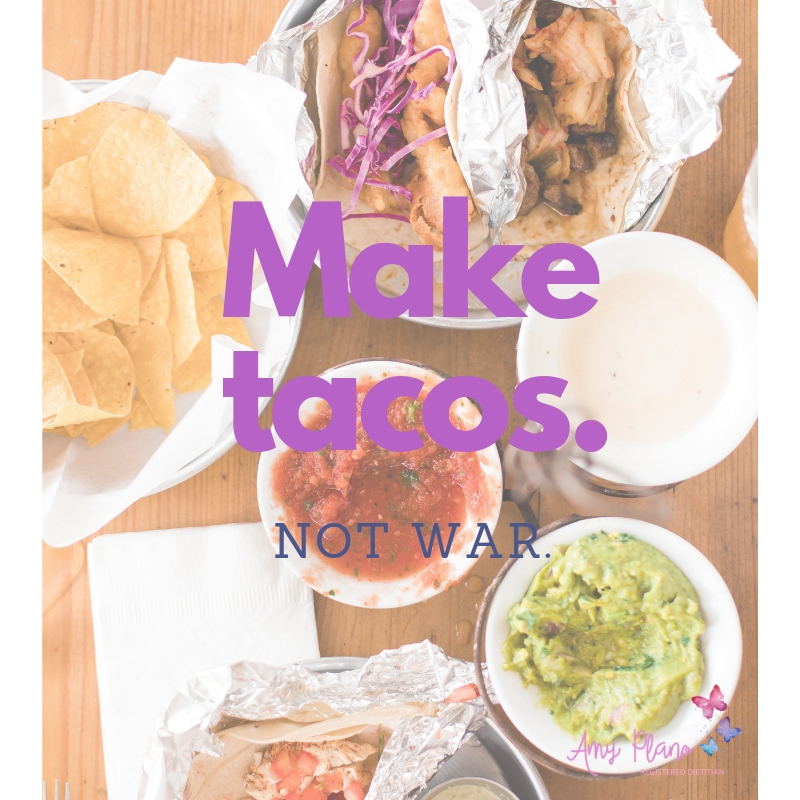
Make Tacos. Not war.
Well I hope you found some inspiration in these recipes. After all it is not every day is National Taco Day! So please enjoy because National Taco Day only comes around every 365 days 🙂
Got healthy taco recipes? I know YOU do my fellow Mexican food lover. Please share in the comments below. Our community will thank you for doing so ♥ ♥ ♥
Hugs & High Fives,
Amy
by Amy Plano | Sep 13, 2018 | General Nutrition, healthy eating, Healthy Fats
What to Look for on a Food Label for Peanut Butter
This week at Quinnipiac University my students in one of my hybrid classes completed a module on food label reading. In this assignment I have them choose one of their favorite, commonly consumed foods and report back to the class on what they learned from reading the food label.
When I asked by a show of hands in last night’s class how many students were surprised by what they learned from the assignment – 25 out 25 hands shot right up. Not surprising as reading a food label can be pretty difficult territory to navigate! In fact for some – it can be pretty foreign.
Therefore, I thought it light of National Peanut Day (which in case you did not know is TODAY in case you didn’t know!) it would be a good idea to tackle what to look for on a food label of one of my most favorite foods – good old peanut butter.



Peanut butter. To my expert knowledge is one of the best foods ever created on this amazing planet. It’s texture, salty taste, and affordability has made peanut butter a staple in most American homes.
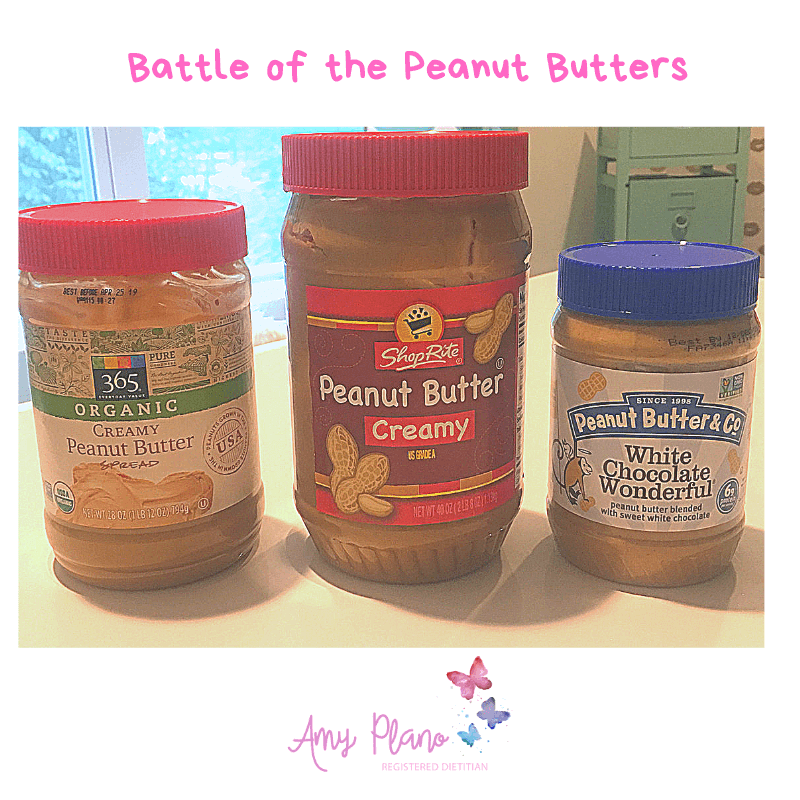
Battle Royale of the Peanut Butters – Let’s the games begin!
So, what is in peanut butter? How is it made? What should we look for when buying peanut butter? Well, it sounds pretty simple in theory. Peanut butter should just contain peanuts and some butter, right? However, this is far from the case. So let’s get down to the nitty gritty and see what we should be looking for on a food label on this beloved food.
5 Important Things to Look for When Buying Peanut Butter
1. Always choose organic.
I promise – I am NOT ‘that’ dietitian. The one who preaches organics as the be-all-end-all of life. In fact, in my practice organics are only something I bring up if YOU bring them up. I have NO agenda when it comes to organics. So if I tell you to buy organic peanut butter there has to be a good reason.
You see, peanuts are one of the most heavily sprayed crops in the US. Insects and all sorts of little creatures ♥ peanuts – just like we do! So, that means the commercial peanut crops are sprayed with a heavy hand when it comes to pesticides.
Therefore, in an effort to decrease this lovely toxic load – choose a peanut butter that clearly states “Organic” on the food label. This information is found on the front of the product and often too on the back of the food label.

Choosing Organic peanut butter is critical!
And remember you do not need to choose a fancy brand. In fact, most store brands of organic peanut butter are equally as delicious as the far more expensive name brand varieties.
2. No added sugars.
I know this sounds like a no brainer. But sugar should never.ever.ever. be listed as an ingredient on a food label for peanut butter. Not in any form. No cane juice, corn syrup solids, high fructose corn syrup, agave, molasses, honey, etc. Because guess what? They all mean one thing – and one thing only – sugar.
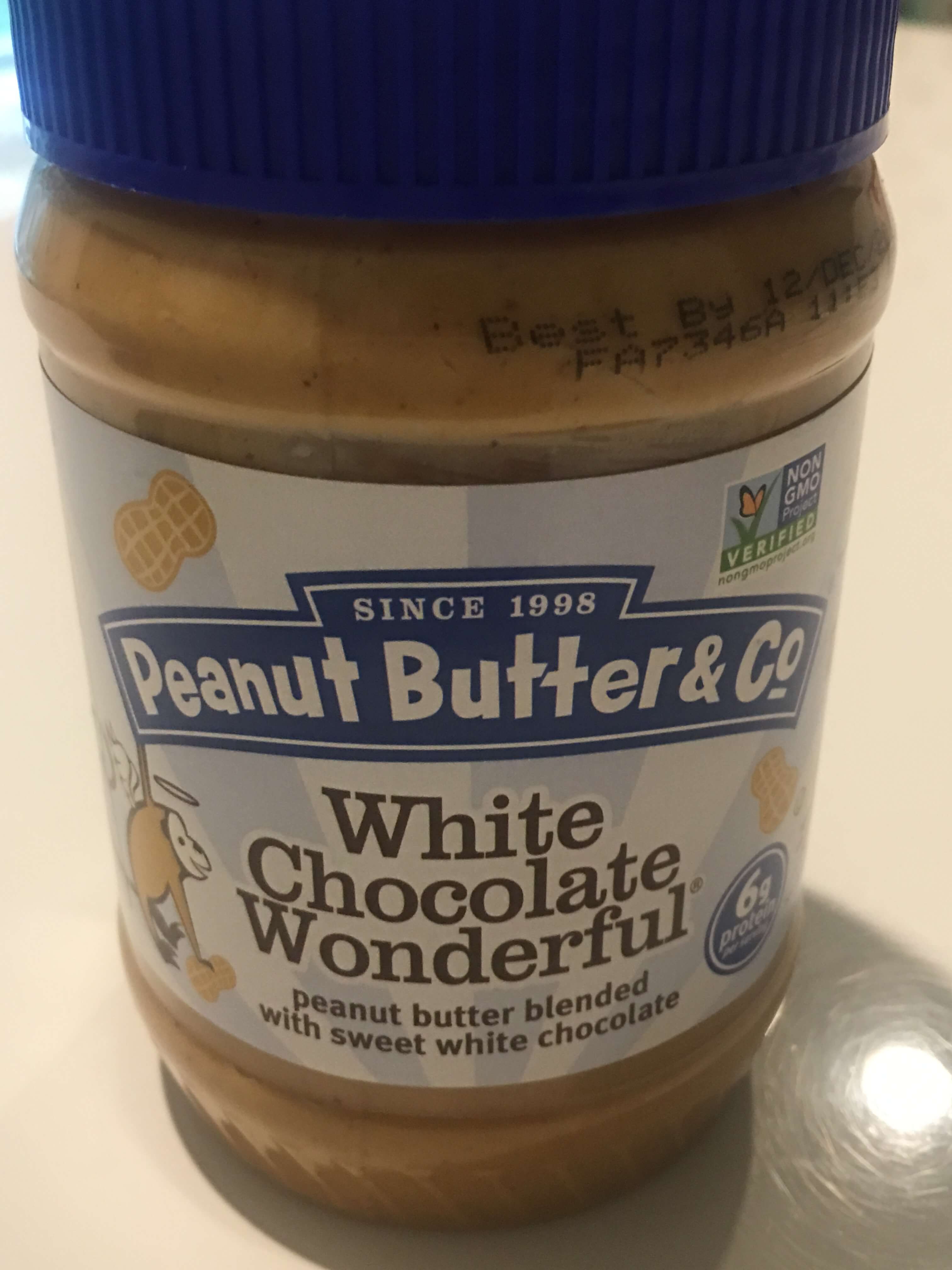
This product (though delicious I might add) contains added sugars – so buyer be aware!
You see food companies are pretty sneaky! Many will often use sugar as a ‘filler’ or just to make an already delicious product sweeter. Don’t fall for it. You are far too crafty smartie pants!
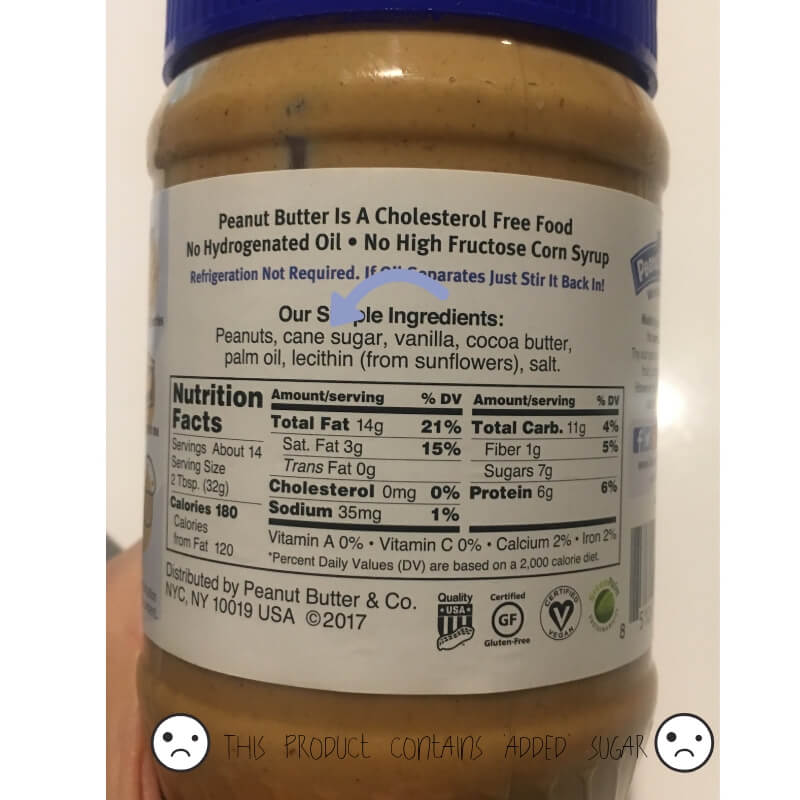
This product contains ‘added’ sugar in the form of ‘cane sugar’
Sugar does not belong in peanut butter. That is unless you are making a peanut butter pie. Which if you know me – understand fully that making peanut butter pies are pretty much my jam!
3. No added oils.
This one may stump you. But guess what makes most peanut butters smooth? Trans fats (a.k.a. hydrogenated oils). Hydrogenated oils are used to improve the texture of peanut butter. They prevent the oils from separating in peanuts and rising to the top.
Trans fats are an unhealthy type of fat. Trans fats tank our healthy cholesterol (HDL) which we want HIGH and increase our lousy cholesterol (LDL) which we want LOW. Some of the most popular peanut butters used to have partially hydrogenated fats in them: Skippy, Jiff as well as many standard store brands. However, given the dangerous nature of trans fats (And the FDA cracking down on using them!) many companies are switching to fully hydrogenated fats. These fats still impart the same qualities with less of an impact on our health. However, truth be told – fully hydrogenated fats while not as risky from a heart health standpoint should be avoided in my book!
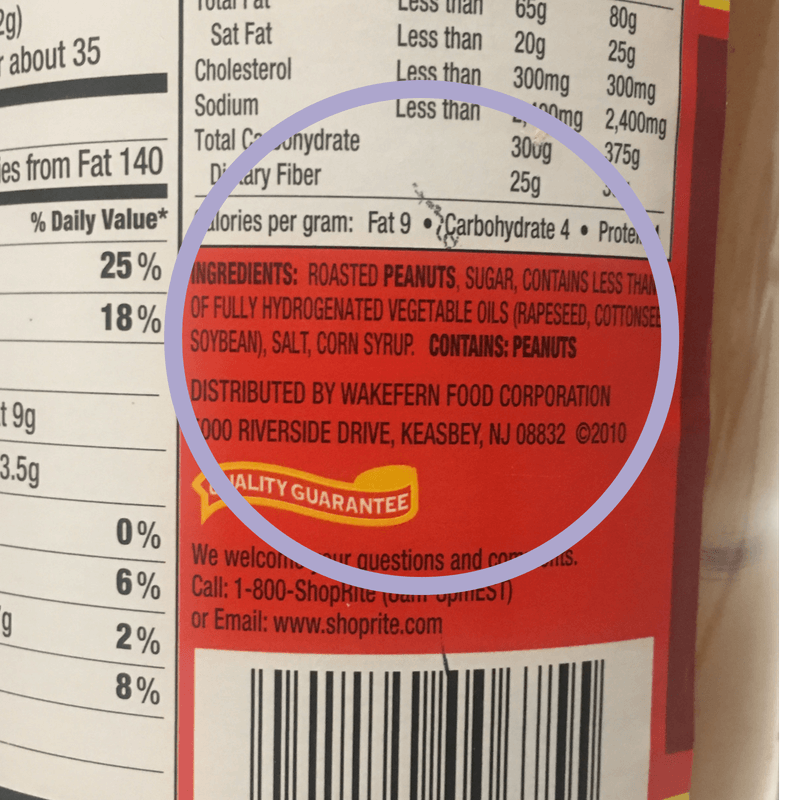
All sorts of garbage here!
When reading a food label to determine whether or not a peanut butter contains trans fats look to the ingredient list for the words: partially hydrogenated vegetable oils. They are generally listed as the second or third ingredient on the food label.
As you can see in the label above – the products contains all sorts of garbage including sugar, salt and corn syrup. Awesome, right? But no trans fats. As if label reading could not get any more complicated. Geez! Nonetheless, trans fat or not – this peanut butter is no bueno 🙁
4. Two Ingredients OR LESS.
Generally when it comes to most foods – the fewer number of ingredients, the better! In all honesty high quality peanut butters should only contain ONE ingredient — peanuts. Bingo!
A little salt can be okay, too. Some grocery stores have grinders that turn peanuts into peanut butter for you. Heck even our local Shop Rite has this – boom! This allows you to purchase however much you like instead of having to buy an 16-ounce jar and you can guarantee only one ingredient.
5. Peanuts as the MAIN ingredient.
Ingredients are listed in descending order by weight. This means the ingredient listed first on the food label occurs in the highest quantity in the product. When viewing the list, peanuts should always be the first ingredient.
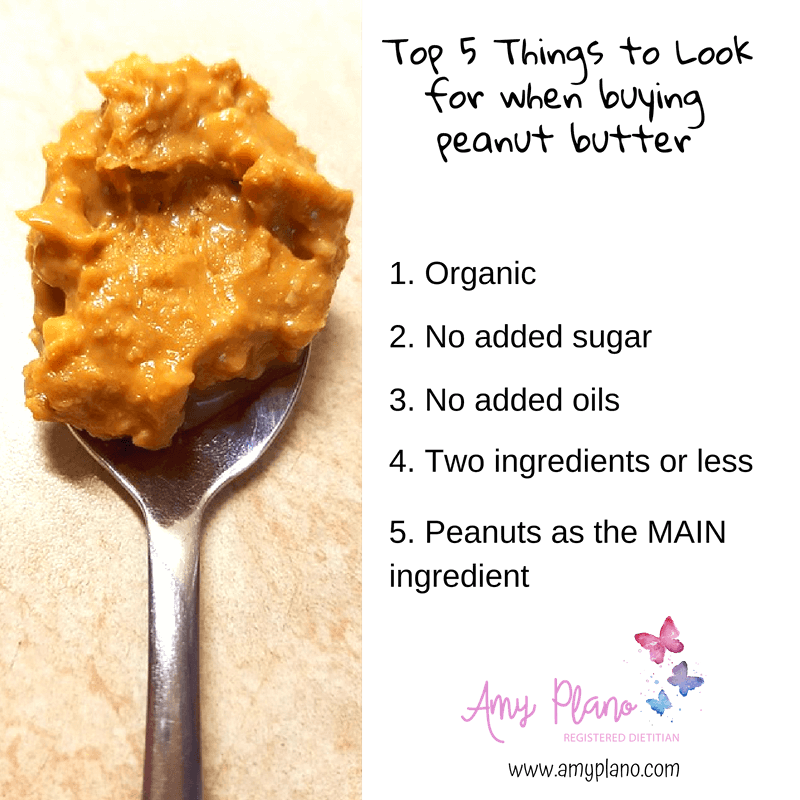
Focus on these 5 things and you will have no problem choosing a high quality peanut butter
Remember my friends peanut butter should JUST be smashed peanuts, period. Brand names shouldn’t matter as long as you follow my suggestions listed above.
My advice is always to make sure the food label hits these 5 criteria and is the least expensive among the choices. No need to get fancy or shell out a lot of money unless you choose to. With that being said – there should be no need to spend more than $6.00 on a jar of high quality peanut butter – after all it is just nuts.
Got tips? Do YOU have criteria that you like to follow when choosing a peanut butter? Is there a brand that you love? Share in the comments below. Our peanut butter loving community would love to be in the know.
Hugs & High Fives,

by Amy Plano | May 14, 2018 | General Nutrition, healthy dairy choices, healthy eating
Who the heck does not like yogurt ? After all the possibilities for its use are endless! It can be used as a base in parfaits, smoothies, soups, pancakes, and can even pinch-hit for sour cream. It is rich in protein and calcium and also contains potassium which is important for ♥ health. Yogurt also contains live, active bacteria cultures. These active bacteria cultures are also known as probiotics and are great for maintaining a healthy gut and digestive system. However, with so many choices choosing the best yogurt can be challenging to say the least!
Navigating the grocery store in search of can be tricky! Need some help grocery shopping? Check out my article on that very topic! I was in Shop Rite the other day and I kid you not – the yogurt aisle almost spans the entire length of the dairy aisle. I remember back in the day – the only two choices were Yoplait and Columbo . There were no flips, dips or cherry pie-flavored yogurts. Just the normal variety of boring flavors like vanilla, peach and strawberry.
Now a days there are SO many different options to choose from. Greek, traditional, flavored, plain, fruit filled, and varying percentages of fat are all factors to consider when buying yogurt. But what do these terms all mean? What is the best one in light of all these choices? Let’s get to the bottom of this madness asap!

What percentage fat yogurt should I buy?
This question is tough. In all honesty – it depends on your #dietarygoals are as well as your overall health.
If you have high cholesterol or are just trying to keep your calories on the low side then choose either a low-fat (1%) or fat-free (0%) variety. These two choices generally have the lowest calorie value and contain a nominal amount of saturated fat. Look for labels that have the lowest amount of saturated fat.
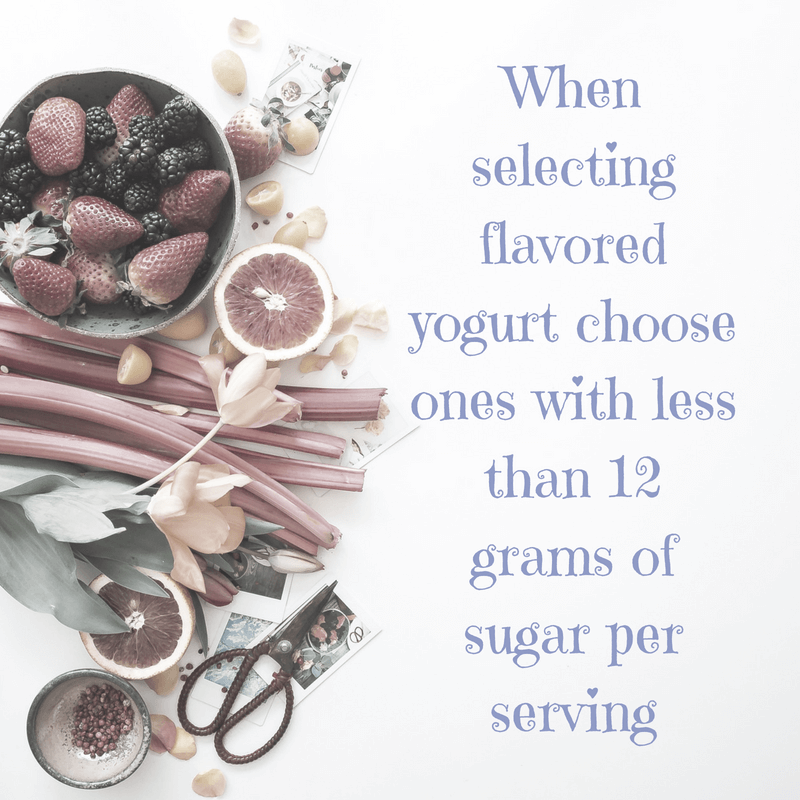
However, if your cholesterol is not an issue and you are just looking for a yogurt with a thicker consistency then opt for a 2 % or full-fat kind.
I personally prefer 2% or full-fat plain yogurt. My favorite traditional brands when I can find them (please don’t laugh 🙂 ) are YoBaby Whole Milk Plain Yogurt or Liberte Plain 2 % Yogurt. Shop Rite generally carries the YoBaby. But lately I can only find the plain Liberte yogurt at Whole Foods. The reason why I like these brands is # 1 (and most important) they taste pretty darn good ! And # 2 both brands contain under 10 grams of sugar. Also they have no added funky ingredients.
Which is best: Greek or traditional ?
Greek yogurt is strained which makes it thicker, creamier, and smoother than traditional kind. When comparing Greek and traditional yogurt, Greek has around double the protein but does have less calcium than traditional kind. Both the Greek and traditional varieties are usually well tolerated by individuals with lactose intolerance. However, the Greek type has less lactose (than traditional) and may be better tolerated than traditional yogurt. Most people prefer Greek to traditional yogurt because of the higher protein content.
Nowadays pretty much every major brand has both a traditional and a Greek yogurt. Even Chobani who started out their career just selling Greek now has a “old-fashioned non-Greek traditional smooth yogurt”. Therefore, you can be brand loyal and still get your pick of the litter!
However, please don’t fret if you just don’t love Greek yogurt! Many of my patients don’t like it and prefer the traditional style instead. Keep in mind – the average American consumes more than their daily requirement for protein. So if you opt for the non-Greek variety you will not be selling yourself short in meeting your protein needs.
Favorite Greek yogurt brands
For the Greek yogurts I personally bounce around brand wise depending upon what is on sale and has the lowest amount of sugar per serving. I shop mostly at Trader Joe’s. But unfortunately (aside from their ‘plain’ Greek) they do not carry a whole bunch of options under 10 – 12 grams of sugar. Some of the Greek style brands in my fridge now are Siggi’s Greek – 2 % Black Cherry, Fage Yogurt-2% plain, and Chobani Plain Whole-Milk Greek Yogurt.
Should I buy plain, flavored, or fruit filled yogurt?
One of the major issues with yogurt is it often has added sugars. It is made from milk (duh!) and therefore has naturally occurring sugar in it, called lactose. Thus, if you look at the nutrition label of plain yogurt, you will notice it has 12 g of carbohydrates. Since this sugar is naturally occurring, it is not of concern. However, what is concerning is the large amount of added sugars in many yogurts. A serving of flavored yogurt can contain an upward of 30 grams of sugar depending on the brand. That is a wholelata sugar! A can of soda has about 24 grams of sugar so the comparison is clear.
How to dodge the sugar
You can skip the added sugars by buying plain yogurt. Then you can be creative and add your own fruit and flavors such as cinnamon and vanilla. Hello fancy pants! You can even go nuts with different extracts such as almond, coconut or coconut to pump up the flavors without the calories or carbs.
When you buy the flavored variety, check the nutrition label and try to buy a containing less than 12 grams of sugar per serving. Some of the brands with the lowest amount of sugars including Dannon Oikos Triple Zero, Chobani Hints, and Siggi’s Greek mentioned above.
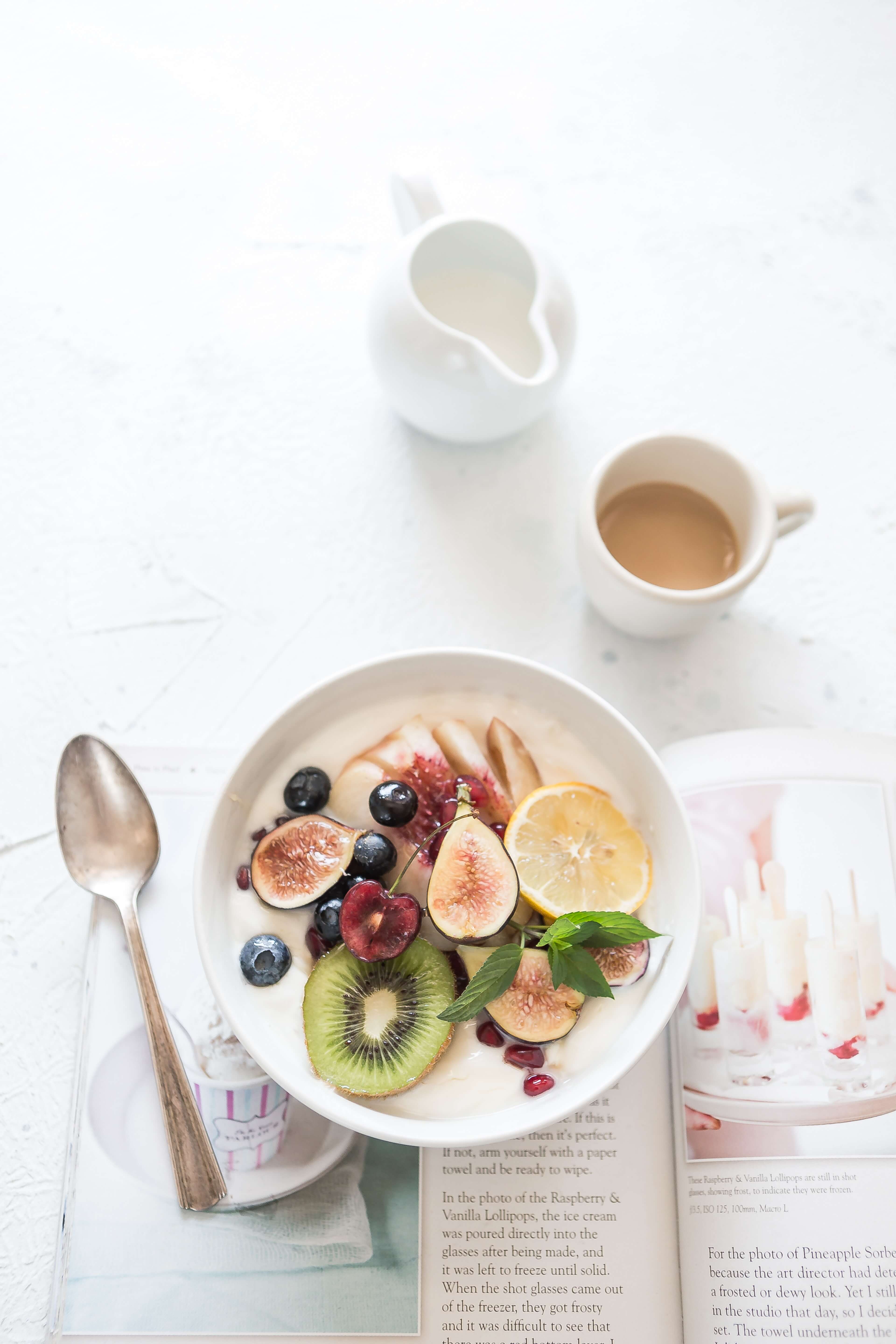
Trying to decrease your overall sugar intake? Choose plain yogurt and add your own fresh fruit #squadgoals
Navigating the yogurt aisle used to be challenging! But now, you should be able to navigate the dairy aisle with ease. Opt for low sugar yogurts that fit your dietary goals, budget and taste palate. Selecting an appropriate yogurt should now be pretty easy!
As always, if you have a question bring the nutrition label to your nutrition visit and the dietitian can review it.
What is your absolute favorite one on the market? Tell us what you think in the comments below.
by Amy Plano | Jan 16, 2018 | General Nutrition, weight loss, weight loss and alcohol
Alcohol 101: How can alcohol fit into my diet?
One of the common questions I receive in my practice is, how can alcohol fit into my diet? Honestly, as an RD I have nothing against alcohol. In fact, if you were to review many of my customized meal plans you would see I actually purposely put alcohol on my patient’s meal plans. While, I personally can count on one hand how many drinks I have in the course of a year it does not by any means make me a hater. Honestly, it seems like I did SOOOO much drinking before I turned 21 (many, many, many moons ago!) that when I finally did actually reach the legal drinking age – I was all set 🙂 SO I will cheer YOU on!
However, as we all know calories in drinks can add up fast. And as a result, instead of seeing results, patients remain “stuck” in a weight loss plateau. Sound familiar?

Since alcohol is a pretty much part of just about every social occasions including family parties and nights out with friends seems like it would be worth chatting about. Right? Whether you are trying to lose weight or build muscle, drinking alcohol too frequently can get in the away of your goals (shocker right?!). However, this does not mean you have to give up the occasional drink or night out with friends. Rather, just do so in moderation. And follow my tips for making the best choices when it comes to alcohol. Winner, winner, winner chicken dinner!
What is a standard drink?
First things first. Before we talk about how alcohol can fit into your diet we probably need to define an alcoholic drink. Most people are surprised to learn what counts as a standard drink. The amount of liquid in your glass doesn’t always match up to the alcohol content of your drink. Different types of beer, wine, and hard liquor can have different percentages of alcohol content.
In the U.S., a standard drink contains roughly 0.6 fluid ounces or 14 grams of pure alcohol.
One standard drink includes:
12 ounces of beer with 5% alcohol content
5 ounces of wine with 12% alcohol content
1.5 ounces or a shot of 80-proof distilled spirits of liquor with 40% alcohol content
What has more calories: beer, distilled spirits, or wine?
The calories per each standard drink are as follows:
• 1.5 ounce drink of distilled spirits (40 % alcohol) is 98 calories, 0 g CHO, 0 g Pro, and 0 g Fat.
• 12 ounce drink of regular beer (5 % alcohol) is about 150 calories, 13 g CHO, 2 g Pro, 0 g Fat.
• 5 ounce drink of wine (12 % alcohol) is about 120 calories, 4 g CHO, 0 g Pro, 0 g Fat.
What are the current recommendations for alcohol?
The Dietary Guidelines for Americans alcohol recommendations differ for men and women. Women are encouraged to limit alcohol to up to 1 drink per day. While men have a slightly longer leash of up to 2 drinks per day. The Dietary Guidelines do not recommend that individuals who do not drink alcohol start drinking for any reason. Translation – there is no nutritional value to drinking. Therefore, no need to establish a “new” habit if you don’t already have one.

Aint’ that the truth ?!?
The Dietary Guidelines also warn about the side effects of excessive drinking. These include: binge drinking, heavy drinking, and any drinking by pregnant women or people under the age of 21. Binge drinking is defined as drinking more than 4 drinks during a single occasion for women and more than 5 drinks during a single occasion for men. Heavy drinking is defined as consuming 8 or more drinks per week for women and 15 or more drinks per week for men. If you are confused, please see above to see what counts as a standard drink.
Consequently, excessive alcohol use can lead to the development of chronic diseases and other serious problems. These may include hypertension, heart disease and stroke. Not to mention liver disease, digestive problems, cancer, learning and memory problems, mental health problems, social problems, and alcoholism. And how about them calories?
What does my drink ‘cost’ me?
I have done my best to establish a list of what I would consider commonly consumed alcoholic drinks. As mentioned previously, the calorie counts mentioned above are just for the alcohol. They do not address the multitude of beverages alcohol can be mixed with. My list below does include the mixers. The list is comprehensive but by no means all inclusive. Furthermore, don’t quote me on all the values – they are more or less estimates and refer to a standard drink. Depending upon who is making your drink – they may pour more or less alcohol and/or add more or less juice/soda/tonic/mix.
If you do not find your drink of choice on this list, you can check out Calorie King for additional nutrition information.
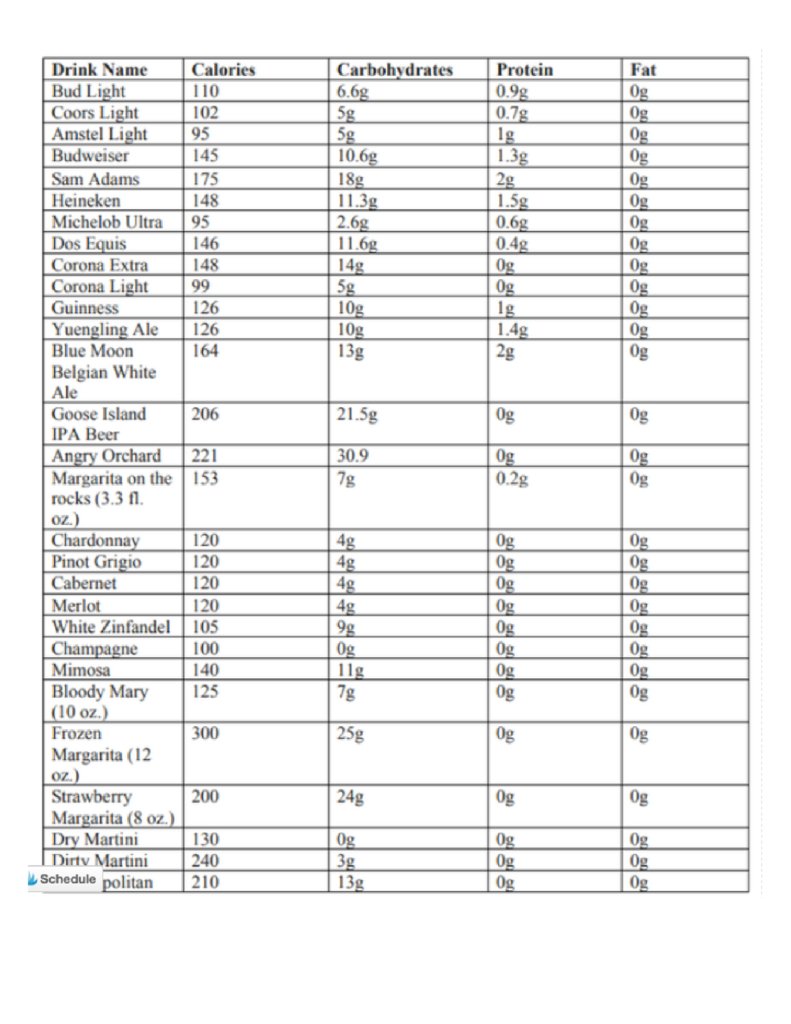
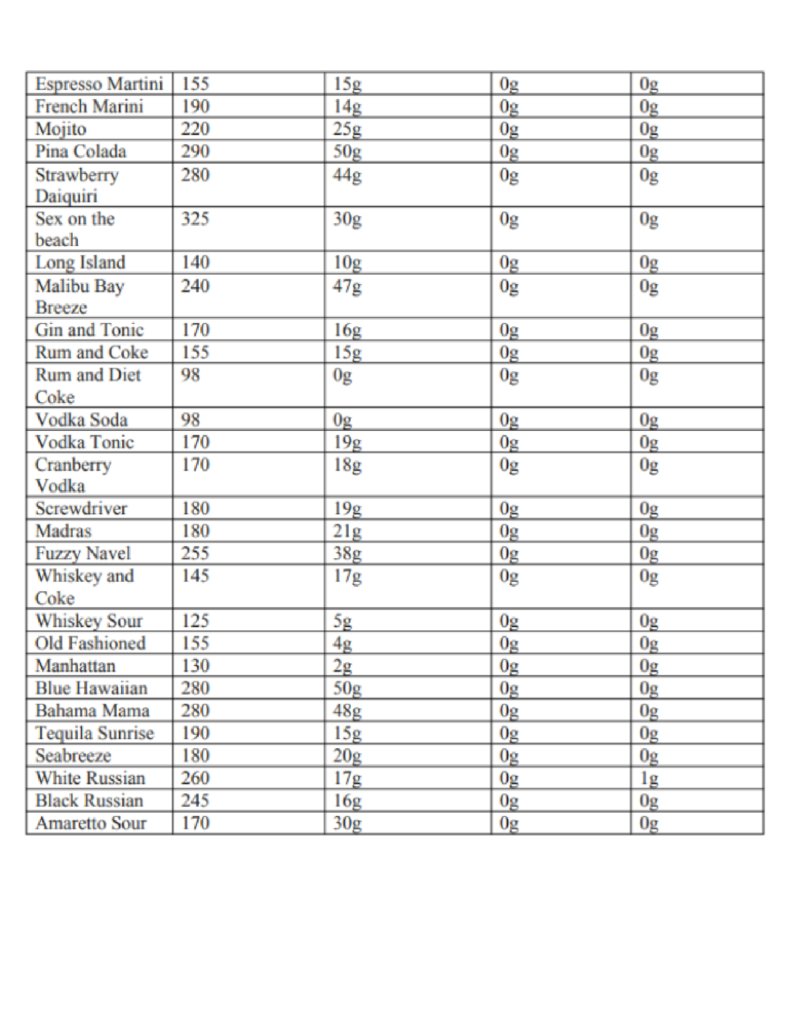
Now that you know the numbers – let’s get down to the basics.
Be mindful of the mixers
The addition of juices, sodas, and sugary syrups are a caloric and sugar force to be reckoned with. And just because your drink is “clear” does not by any means it is free of calories. There’s a common misconception that tonic water is the same as seltzer water, but it actually contains a lot of calories and sugar. Or some folks think because their drink is mixed with juice – it is a better choice. Most juices contain at least 110 calories and 25 grams of sugar per 8 ounce serving. So you add in a shot of alcohol and you are looking at + 220 calorie plus drink. While this may seem somewhat benign when you are on a calorie budget every calorie counts.
Instead try herb infusions, flavored club soda, or a squeeze of citrus. And if you choose so, use diet soda instead of sodas laden with sugar. Below are examples of low calorie mixers.
* Diet soda or diet tonic: 0 calories
* Light orange juice (8 oz): 50 calories
*Diet cranberry juice (8 oz): 5 calories
*Light cranberry juice (8 oz): 40 calories
*Light lemonade (8 oz): 5 calories
*Baja Bob’s sugar-free margarita or sweet ‘n’ sour mix: 0 calories
*Lemon or lime juice (1/2 oz): 10 calories
*DaVinci or Torani’s sugar-free syrups: 0
Keep it Simple
Or you can even skip the mixer altogether. Try ordering your favorite spirit or one of the new flavored liquors on the rocks (translation just on ice). Infused and ‘flavored’ vodkas are very popular because they are not sweetened but infused with flavor. There are a whole host of flavors ranging from jalapeno to peach to blueberry, to lechee fruit. You name it – there is probably an infused liquor with your favorite flavor. And best of all the flavor exists without adding any extra calories. The alcohol itself has calories (9 calories/gram) but you are saving on the calories from the mixer without compromising taste.
One of my favorite things to do (for the handful of drinks I have per year) is to make my own infused tequila. I take a whole pineapple and slice it into small disks. Next, I take about 4-5 jalapenos – seeds and all and chop them up. I then put the sliced pineapple and peppers into a tall glass pitcher. Next, I pour 2-3 cups of tequila over the fruit and peppers. I cover the mixture let it sit for about 4-5 days. Each day I muddle the mixture with a wooden spoon to release the juices and oils. Once the mixture is good and spicy I strain the liquid through a fine sieve and throw out the fruit and peppers. Lastly, I refrigerate the tequila until I am ready to use it for spicy margaritas! Yum!
Settle for a “spritzer”
Sounds pretty fancy, right? If you just want to be social and club soda won’t cut it with the company you’re keeping, ask for a wine spritzer, heavy on the spritz. All this is wine mixed with club soda. If you want to get extra fancy you can even try some of the zero calorie flavored seltzers to pump up the flavor.
Hydrate healthfully
You knew this was coming. Alcohol is a diuretic. Replacing fluid, particularly in warmer climates (hello Caribbean vaca), is essential. Calories (and sugar!) aside, try to make every other drink either club soda, sparkling water, or just plain water. Adding ice cubes to your beverage will help hydrate you and also make your glass of booze feel bigger.
Volunteer to be the DD
The best way to prevent alcohol from derailing your diet is to avoid drinking altogether. Why not volunteer to be the DD (designated driver) and save your group taxi or Uber costs by offering to drive? While it may not be as fun as indulging with your group, you’re the one who’ll wake up the next day without a food or alcohol hangover. And as we all know that feels pretty dang good.
Conclusion
Bottom line – If you budget your calories carefully, you can safely “afford” to have a drink or two on a special occasion. But drinker be ware. Drinking loosens your inhibitions and may prompt unconscious eating. Additionally, drinking alcohol can also make you feel hungrier because alcohol can lower your blood sugar. SO why not grab a quick bite before you imbibe? Some good pre-party noshes: a small meal or snack containing fiber, protein and healthy fat. These might include a low-sodium chicken soup, greek yogurt and fruit, low-fat cheese and whole-wheat crackers, or a handful of nuts.Therefore, from a health standpoint, calories aren’t the only thing to consider. Practice moderation and always, always, always have a designated driver. Heck call me – and I will come get you!

by Amy Plano | Nov 13, 2017 | General Nutrition
Healthy Baking Substitutions to Lighten Up Your Holiday Treats
I seriously cannot believe it is November! Can you?! Next week is Thanksgiving (my favorite holiday, of course!) and before you know it Christmas will soon be here. Now is the time of year for holiday parties and celebrations with family and friends. This also means it is the time of year for delicious and tempting desserts.

Oh my! But, the good news about this year is I have some tips for making your traditional dessert recipes healthier. Check out my healthy baking substitutions and you can enjoy that cookie, cake, or brownie without so much guilt.
Substitutes for flour:
Black beans. Using black beans instead of flour can add protein with the same great taste. This is particularly tasty when baking brownies. When baking, swap out 1 cup of flour for 1 cup of black bean puree.
Whole wheat flour for white flour. Using whole wheat flour instead of white flour, adds fiber, which helps with digestion. Use 7/8 cup of whole-wheat flour for every cup of white flour.

Substitutes for sugar:
Unsweetened applesauce. Applesauce provides the same sweetness without the extra calories and sugar. You can substitute applesauce with sugar in a 1:1 ratio. However, you should reduce the amount of liquid in the recipe by ¼ cup.
Vanilla extract. Adding vanilla extract and cutting the amount of sugar down can give great flavor without extra calories. You can try cutting 2 tablespoons of sugar out of your recipe and adding an extra ½ teaspoon of vanilla extract.
Stevia. Stevia is a natural sweetener that is lower in calories, but also much sweeter than sugar. Since stevia is sweeter, a recipe calling for 1 cup of sugar should only be swapped for 1 teaspoon of liquid stevia or 2 tablespoons of stevia powder.
Substitutes for oil or butter:
Unsweetened applesauce. Applesauce gives the same consistency without the fat. It works well in breads and muffins. Substitute half of the fat in your recipe with applesauce.
Avocado puree. Avocado provides creaminess with a healthy addition of unsaturated fats. This tends to be better in brownies and chocolate desserts. Using 1 cup of avocado puree per cup of butter works.
Mashed bananas. Bananas add a good consistency with added nutrients like potassium, fiber, and vitamin B6. One cup of mashed banana works perfectly in place of 1 cup or butter or oil.

Prunes. Prunes can make a great substitute for butter and cut the calories and fat down. Combine 3/4 cup prunes with 1/4 cup boiling water, and puree to combine. Sub in equal amounts in most dark baked good recipes.
Greek yogurt. Substitute for Greek yogurt for oil. This can help cut fat and calories without a difference in taste. Substitute 1 cup of oil for ¾ cup of Greek yogurt.
Substitute for cream:
Evaporated skim milk. It provides the same consistency with less fat. Use 1 cup of evaporated skim milk for 1 cup of cream.
Please make sure you try these healthy baking substitutions prior to serving a recipe to others. Healthy can make a great difference, but it takes practice to master them. Making recipes healthier is worth the extra effort!
Hugs & High Fives,




